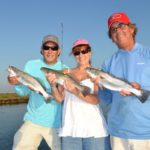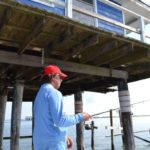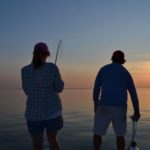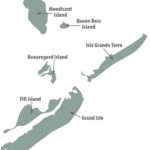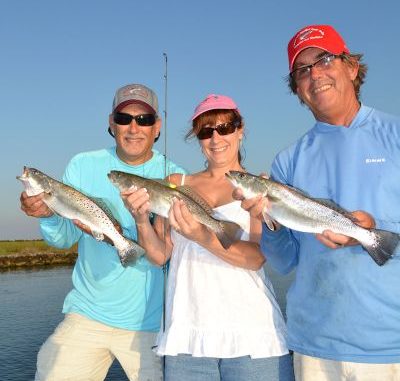
The beach gets all the glory, but the waters to the north of Grand Isle are the real fish factory in May.
May and Barataria Bay go together like Christmas and Santa, like Brad and Angelina, like cheese and whiz.
If it’s May, there will be fish in Barataria Bay. Period. End of story.
They’ll be there, and it’s up to you to go catch them.
But therein lies the rub. May is a moody hag who can’t decide if she wants to be March or July. She’s a month who acts like it’s always her time of the month.
She lures fish in, sucks them to where they’re supposed to be and then laughs as anglers sit at the dock cursing the 25-knot gale that no weatherman foresaw.
There was a time when the fathers of these anglers could motor away from Louisiana’s only inhabited barrier island with three fingers closed in a fist and one pointed straight up at the month of May. Her hot air was powerless against them because Barataria Bay provided more protected water than a kiddie pool at Disney World.
May could pick any direction she wanted, and there was always somewhere to get out of her stale breath.
But those days are long gone. They must have existed. We’ve all seen pictures. We can blow the dust off an encyclopedia at some library and look up the maps. There was actual LAND rimming Barataria Bay. Really! Check it out for yourself.
Now, nothing but water — mile after square mile of it. Leave Grand Isle, and you can’t even see the other side of the bay. Use binoculars if you want; they won’t help. It’s like Waterworld starring Kevin Costner, except without the horrendous dialogue and plot.
So when May longs for the good old days of March, there’s little anglers can do. The speckled trout are there, but they might as well be on the moon.
But every now and then May decides she’s really July, and just wants to spend the day lounging in a hammock with a glass of lemonade. She gives anglers the full run of Barataria Bay and all of its trout, and she couldn’t care less.
That’s the day that greeted Capt. Danny Wray ,and Chris and Vicki Holmes during a trip last May. It was perfect. The wind started flat calm and built to a raging 3 mph all day.
“Doesn’t get much better than this,” Wray said at the first stop of the morning.
The sun was still just a rumor, and what had to be more trout than the dollars in the deficit were already making life a living hell for fleeing, scurrying and popping shrimp as far as the eye could see.
Wray added No. 2 kahle hook ornamentation to the horn of a protesting shrimp, and threw it into the fray. It didn’t look like the water could possibly hold another shrimp, and it didn’t for very long. A trout yanked Wray’s cork under, but he swung and missed.
No problem: Vicki, standing next to him, took up the slack, and boated the first of many fish on the perfect May morning.
Catching fish out of Grand Isle during a calm day in May is so easy it makes second-grade math seem like quantum physics in comparison.
“The fishing action in May is off the charts,” Wray said.
Wray’s late-spring strategy is to begin every day on the backside of Grand Isle, and he recommends that anglers heading there over the next several weeks do the same.
“I’d just start hitting some points in the back and try to get on some fish that are big enough to keep, and then work your way down and fish the beach,” he said. “Just mix it up. Don’t be tied into one plan.”
One plan that Wray is ALWAYS tied to is getting on the water before the roosters even realize dawn is approaching.
“You’ve got to get up early,” he said. “That’s one of the biggest things I see. People show up at the marina at 6:30. By then, you should have been out there doing your thing.”
An angler out there early will have an hour or more of prime fishing time before other anglers even reach the marina. He might have half a limit of fish on ice before the other guy has even backed his boat into the water.
One of the other big mistakes Wray sees anglers regularly making is fishing too close to points. They feel like the boat needs to be within casting distance of the point, when in fact the boat is likely sitting over the best fishing spot.
Wray said he always catches more trout in the waist-deep water off of points rather than in the shin-deep water near the points. He stops his boat a couple hundred yards out, and trolls in, casting the whole time. As soon as he hits a fish, he lowers his Power-Pole.
Wray is a master at figuring out how current impacts certain spots, and how trout will relate to those spots as a result. In general, he likes to fish the upcurrent side of anomalies, and is always on the lookout for current lines.
On last year’s trip with the Holmeses, Wray stopped to fish a rock embankment that emerged perpendicular to Grand Isle at Fifi Island. A rising tide was pushing in through Barataria Pass and compressing water against the rock wall, stopping baitfish and shrimp, and making them vulnerable to the marauding speckled trout.
“You just got a whole corridor of mullet here — finger mullet,” he said. “When you see these little compressed things of finger mullet, I guess that the trout just hover underneath them, deciding when it’s time to eat one.
“It’s been like that all week — a bunch of little trout, but then you find the mullet, and you find some bigger ones.”
Sure enough, Wray moved over to the mullet, and he and the Holmeses began boating some really solid speckled trout.
Wray fished the rock wall at Fifi nearly every morning last April and May, and always boated some nice trout there. He also fished Queen Bess, Beauregard and Mendicant regularly.
Wray also keeps track of submerged islands on his GPS, and fishes them when the water around them looks good.
One in particular was an annual hotspot for him on the edge of the Barataria Waterway while it was still above water. Now that it’s entirely sunken, it still produces fish.
“I know people pass me and wonder what in the world I’m fishing,” Wray said.
To show his guests for the day just how good the fishing is in the area, Wray ran over to last year’s hotspot — Four Bayous Pass. The fish began showing up in Four Bayous early last April, and they only got more plentiful as the spring progressed.
Most of the camps in the area had two or three boats on them, but Wray’s favorite — a blue one — was vacant. He eased in, and worked his way to the east side, where a horseshoe-shaped reef has delivered for him on many past trips.
“This is my favorite camp, ol’ blue,” Wray said. “You’re my boy, blue!”
The reef delivered several large school trout to the fishing crew before slowing down. Wray trolled over to the south side of the camp, and found another crop of eager fish.
The anglers were throwing live croakers on Carolina rigs as well as under corks, and the trout would, characteristically, smash the croakers before coming back in to ingest the baits.
Wray is happy when he and his clients limit out at the close-in hotspots behind Grand Isle, but he never minds running to Four Bayous.
“It’s just got a lot of structure, and it’s a fairly shallow pass,” he said. “It’s got lots of oysters, it’s got shrimp, it’s got current.
“The only thing that’ll mess it up is wind, and we’ve had a pretty good run of it this year being calm.
“I just love this place. It kind of tells the whole story of coastal erosion, and it also showcases all the riches here. It’s just an awesome place.”
Awesome, indeed. Especially when the winds are calm.
The month of May. She’s such a sweet little thing.
